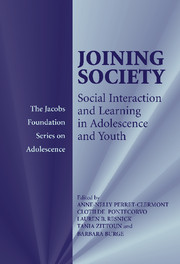Book contents
- Frontmatter
- Contents
- List of Contributors
- Foreword
- Preface
- I Introduction
- II Youth-Constructed Socialization
- III Personal Agency Through Collective Activity
- 8 Learning and Thinking in Adolescence and Youth: How to Inhabit New Provinces of Meaning
- 9 From the Provinces of Meaning to the Capital of a Good Self: Some Reflections on Learning and Thinking in the Process of Growing Adult in Society
- 10 Preapprenticeship: A Transitional Space
- IV Learning in Practice and Discourse
- V Intergenerational Sites for Thinking
- VI Pathways to Adulthood in National Context
- Index
- References
10 - Preapprenticeship: A Transitional Space
Published online by Cambridge University Press: 08 January 2010
- Frontmatter
- Contents
- List of Contributors
- Foreword
- Preface
- I Introduction
- II Youth-Constructed Socialization
- III Personal Agency Through Collective Activity
- 8 Learning and Thinking in Adolescence and Youth: How to Inhabit New Provinces of Meaning
- 9 From the Provinces of Meaning to the Capital of a Good Self: Some Reflections on Learning and Thinking in the Process of Growing Adult in Society
- 10 Preapprenticeship: A Transitional Space
- IV Learning in Practice and Discourse
- V Intergenerational Sites for Thinking
- VI Pathways to Adulthood in National Context
- Index
- References
Summary
The process in which young people make the transition to adulthood may be considered a developmental process with at least two aspects. On the one hand, such a process necessitates a newly mature sense of one's own identity, which in turn entails a redefinition of the roles one plays socially, particularly with regard to new social groups. On the other hand, adulthood means acquiring new skills, knowledge, and know-how, all of which the young adult will need in order to play new social and professional roles. These two aspects of becoming an adult have traditionally been studied separately: School, the place where skills are acquired, is the focus in some studies; and social groups, wherein young people develop their sense of identity and social skills, are the focus in other studies. Some innovative studies have addressed both issues concurrently, however, showing that socialization and the construction of identity may also take place at school (Coulon, this volume) and that social groups often allow young people to acquire certain complex skills (Heath, Hundeide, this volume).
These two different spaces often function in complementary ways for young people. There is a direct link between the way in which a person gets involved in an activity and the way he or she makes sense of that action. This is particularly true of the social visibility of that action and the identity-related benefits he or she might procure via that action (Carugati, Rijsman, this volume).
- Type
- Chapter
- Information
- Joining SocietySocial Interaction and Learning in Adolescence and Youth, pp. 153 - 174Publisher: Cambridge University PressPrint publication year: 2003
References
- 2
- Cited by

